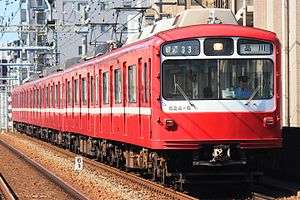Keikyu 800 series
| Keikyu 800 series | |
|---|---|
|
Set 824 in July 2014 | |
| In service | 1978– |
| Refurbishment | 1994–2001 |
| Scrapped | 2011– |
| Number built | 132 vehicles |
| Number in service | 72 vehicles (12 sets) |
| Number scrapped | 60 vehicles |
| Formation | 3/6 cars per trainset |
| Operator(s) | Keikyu |
| Depot(s) | Kanazawa, Shinmachi |
| Specifications | |
| Car body construction | Steel |
| Car length |
18,500 mm (60 ft 8 in) (end cars) 17,860 mm (58 ft 7 in) (intermediate cars) |
| Width | 2,798 mm (9 ft 2 in) |
| Doors | 4 per side |
| Maximum speed | 100 km/h (60 mph)[1] |
| Traction system | Chopper Control |
| Acceleration | 3.5 km/h/s[1] |
| Electric system(s) | 1,500 V DC |
| Current collection method | overhead wire |
| Track gauge | 1,435 mm (4 ft 8 1⁄2 in) |
The Keikyu 800 series (京急800形) is an electric multiple unit (EMU) train type operated by the private railway operator Keikyu on commuter services in the Tokyo area of Japan since 1978.[1]
Formations
Initially delivered as three-car sets,[1] as of 1 April 2016, the fleet consists of 12 six-car sets, formed as follows, with all cars motored (M cars).[2]
| Designation | M1c | M2 | M3 | M1 | M2 | M3c |
|---|---|---|---|---|---|---|
| Numbering | 8xx-1 | 8xx-2 | 8xx-3 | 8xx-4 | 8xx-5 | 8xx-6 |
- The "xx" in the car numbers corresponds to the set number.
- The two "M2" cars are each fitted with two lozenge-type pantographs.[2]
Interior
Passenger accommodation consists of longitudinal bench seating throughout.[1]
- The interior of set 821 in September 2013
 The gangway connection between former cab cars 805-3 and 806-1 in May 2012
The gangway connection between former cab cars 805-3 and 806-1 in May 2012
Liveries
When delivered, the 800 series sets were painted in the standard Keikyu livery of vermillion red with white window surrounds, but were later repainted into all-over vermillion red with a white bodyside stripe following the introduction of the 2000 series trains.[1]
- Three-car set 802 in original livery in January 1983
 Six-car set 813 in later livery in July 2006
Six-car set 813 in later livery in July 2006
Revival livery
In November 2016, set 823 was repainted into the original-style livery with white window surrounds.[3]
 Reliveried set 823 in November 2016
Reliveried set 823 in November 2016
History
The fleet underwent life-extension refurbishment between 1994 and 2001.[1] This involved upgrading the train interiors and also forming 6-car sets from the remaining 3-car sets by removing the cab ends and adding gangway connections.[1]
Withdrawals commenced in 2011 following the introduction of new 6-car N1000 series sets.[1]
References
- 1 2 3 4 5 6 7 8 9 私鉄車両年鑑2012 [Japan Private Railways Annual 2012]. Tokyo, Japan: Ikaros Publications Ltd. February 2012. p. 122. ISBN 978-4-86320-549-9.
- 1 2 私鉄車両編成表 2016 [Private Railway Rolling Stock Formations - 2016] (in Japanese). Japan: Kotsu Shimbunsha. 25 July 2016. p. 37. ISBN 978-4-330-70116-5.
- ↑ 京急800形823編成がリバイバル塗装で出場 [Keikyu 800 series set 823 outshopped in revival livery]. Japan Railfan Magazine Online (in Japanese). Japan: Koyusha Co., Ltd. 3 November 2016. Archived from the original on 4 November 2016. Retrieved 4 November 2016.
External links
| Wikimedia Commons has media related to Keikyu 800 series. |
- Keikyu 800 series official information (in Japanese)

